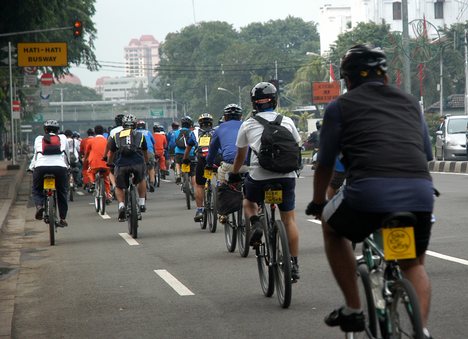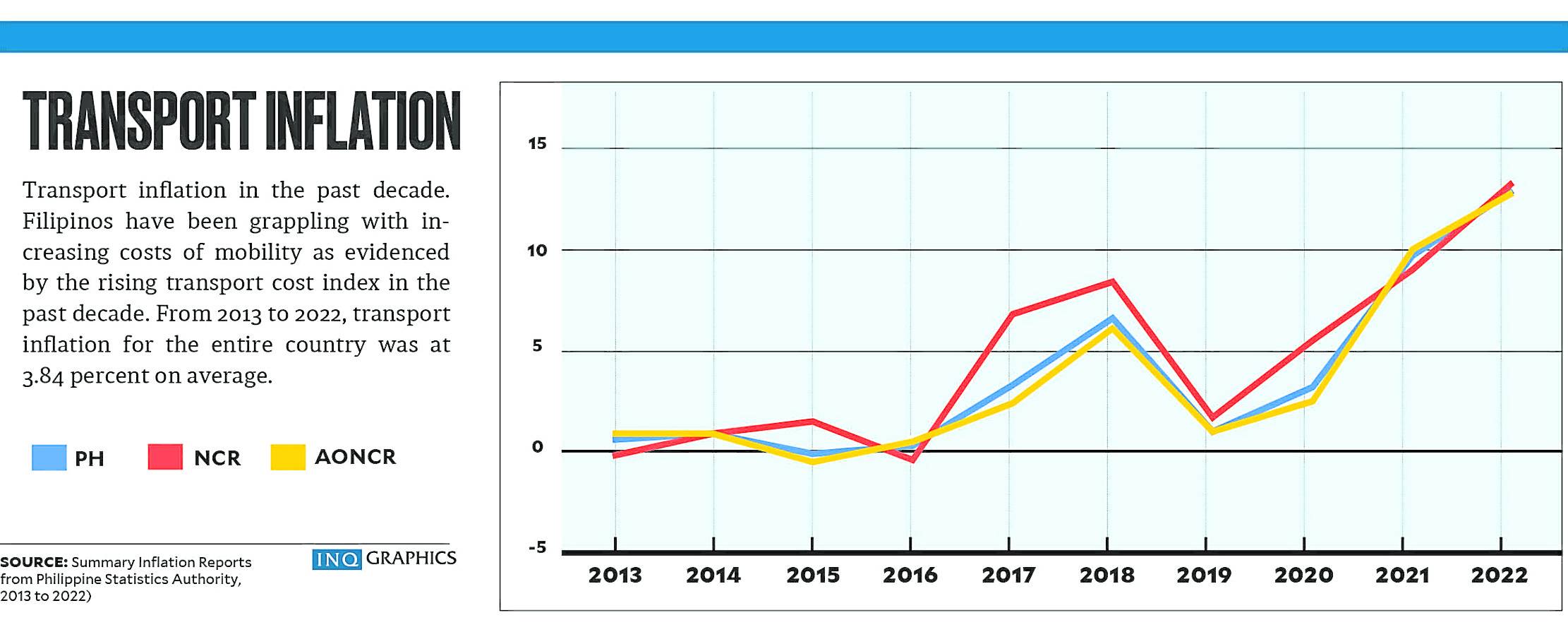Cost of mobility: As prices bite, some consumers turn to active transport

CYCLING, which is an inexpensive way to commute and avoid traffic chaos, is one of the best all-round cardiovascular exercises.
(First of a series)
Charles Tan, a 33-year-old medical oncology fellow, has passion for saving lives, time and money.
Since the start of this year, the millennial doctor has been pedaling his way to work at a hospital in Bonifacio Global City from his home in Quezon City, which he finds convenient. Tan gets on the road just before the morning rush and arrives early. It usually takes him 35 to 45 minutes of cycling to go to work, much shorter than an hour-and-a-half commute.
“Time is very precious for us. We work long [hours]. If we take more time commuting, we have less time to do research and readings,” he tells the Inquirer. The doctor, who learned how to ride a bike when he was little, says biking has become a viable mode of transportation because the hospital where he is working has bike racks. It also has a shower facility so all of the staff biking to work can freshen up before starting their shift.
Instead of paying for ride-hailing services or tricycle rides, Tan also saves a lot by biking when he needs to do errands.
When the pandemic struck, active transport such as biking has become more popular as this allows the public to commute with less risk of exposure to COVID-19. This has proven to be a cheap alternative as well for some, given the increasing cost of transportation brought about by a slew of factors following the reopening of the economy.
Rising transport index
Transport inflation significantly slowed down to -0.5 percent in May from 2.6 percent the previous month and 14.6 percent in the same month last year, according to the Philippine Statistics Authority (PSA).
Looking at the reports in the past decade, however, data show that the cost of mobility has been on the rise, especially in recent years, due to the spike in fuel prices, among others.
From 2013 to 2022, transport inflation for the entire country averaged 3.84 percent. It peaked in 2022 during the 10-year period at 12.9 percent after registering 9.7 percent in 2021.
Transport inflation in the National Capital Region (NCR) was the highest among all the regions and it was even quicker than the national average during the 10-year period at 4.65 percent, PSA data show. In Metro Manila, transport inflation soared the highest in 2022 at 13.3 percent.
In comparison, transport inflation averaged lower at 3.66 percent in 2013 to 2022 in areas outside NCR.
On average, the cost of mobility had risen faster compared with the overall inflation—estimated at 3.08 percent—from 2013 to 2022.
Michael Ricafort, chief economist at Rizal Commercial Banking Corp., in an interview with the Inquirer, recalls that Russia’s war on Ukraine has triggered commodity prices to go up due to constrained supply chains.
He notes that the global crude oil price peaked at $130.5 per barrel in March last year before going down to $75 level now. “The Russia-Ukraine war that led to higher fuel prices triggered second-round inflation effects or the increase in the prices of other goods and services in the economy, especially higher wages and transport fares, thereby triggering price hikes in other affected products,” he explains.
ING Bank senior economist Nicholas Mapa, as such, tells the Inquirer that the high transport cost can “sap precious purchasing power away from other more essential goods and services, thereby lowering overall economic activity.”
“Being overly reliant on energy from abroad exposes us on two fronts, with price spikes in energy prices on top of exchange rate fluctuations, leaving us susceptible to being very reluctant price takers in an unforgiving market,” Mapa stresses.
Passenger woes
According to a report by think tank Fitch Solutions, the Philippines is expected to source 78 percent of its total fuel this year from international markets. Net oil imports are expected to grow around 3.5 percent between 2022 and 2031 as demand is projected to grow by an average of 3.4 percent during the period.
One direct impact is the increase in passenger fares.
“The most significant contributor to inflation for this subsector is land transportation, with bus and coach, taxi and hired car and other transport all seeing hefty increases in prices due to expensive energy and the revitalized demand for transport with the economy reopening,” says Mapa.
To recall, the jeepney base fares were raised multiple times last year from P9 to eventually reach P12 amid the accelerating prices of diesel.
The Land Transportation Franchising and Regulatory Board also approved a P2 increase in base fare for city and provincial buses for the first 5 kilometers last year. Flag-down rate or minimum fare for taxis were also raised to P45.
By Aug. 2, minimum boarding fare at Light Railway Transit Lines 1 and 2 will increase to P13.29 from P11 while the additional fare per kilometer will rise to P1.29 from P1.
Owning a vehicle
Operation of personal transport equipment has become expensive as well.
Mapa explains that the pickup in demand for mobility following the easing of COVID-19 restrictions has contributed to the heating up of the index.
“For example, fuels and lubricants for personal transport shot up significantly as gasoline and diesel prices shot up abruptly,” he notes.
“Gasoline prices rose by more than 50 percent while diesel prices skyrocketed by more than 90 percent during last year’s peak,” he adds.
Nevertheless, car dealers have seen better sales. The Chamber of Automotive Manufacturers of the Philippines Inc. and the Truck Manufacturers Association recently reported that the industry had sold 166,104 units in January to May, up 31.1 percent from the same period last year.
Toyota Motor Philippines, the market leader, more than doubled its net income to P4.5 billion in the first quarter after selling 45,205 units. It has implemented a 2-percent increase in prices, which supported its bottomline.
“Demand for motor vehicles remains robust in line with the sustained high levels of economic recovery,” says Vince Socco, chair of Toyota distributor GT Capital Auto and Mobility Holdings Inc.
More money in pockets
“For persons using public transport or a private motor vehicle daily, transportation costs can eat up over 20 percent of a person’s daily income. Using a bicycle enables a person to save a sizable amount, which could be applied for health, food and education needs,” Move as One Coalition co-convener Robert Siy tells the Inquirer.
In a larger scheme, greater adoption of active transport mode creates positive economic impact. A 2021 study titled “Bikenomics: Assessing the value of cycling in the Philippines” estimates that an individual can save over P281,000 annually, which is equal to purchase of 6,119 kilograms of rice, a staple in every Filipino meal.
The research, conducted by transport advocacy group AltMobility PH and Friedrich Naumann Foundation for Freedom, also calculates that Metro Manila commuters spend about 188 hours or 23.5 days in traffic every year, costing the economy P26.79 million. Further promoting active transport, which also includes walking, is seen to mitigate losses due to heavy traffic.
AltMobility director Ira Cruz, in an interview, says these figures have likely gone up since then amid the rising consumer prices.
Cost of biking
Biking comes with a price, albeit cheaper compared to other mobility options.
Kevin Skinker, a 31-year-old entrepreneur who owns a bike shop in Pasig, tells the Inquirer that bikers visit their outlet for basic tune-ups, which cost about P150. The maintenance activity, performed by an in-house mechanic, includes brake and shifting check.
He notes it can be expensive if customers request for additional services, like changing tires or replacing bike gears. Some are even opting for upgrades—including better grips and pedals—for more efficient riding experience.
Skinker, who opened his shop just a year ago, says among their best-seller models is the gravel bike, which is a drop-bar bike that provide bikers flexibility as these can be ridden on different surfaces. Each unit costs around P20,000 or higher depending on the customization involved, if any.
Bikers are also buying accessories, such as helmets, shirts, bags and bike shoes.
While there has been great demand for bikes, Skinker foresees the rise of electric scooters as the next mode of alternative transport. Such models, after all, require less human effort to operate. He is now in talks with potential suppliers so his bike shop can offer them as well.
To be continued
